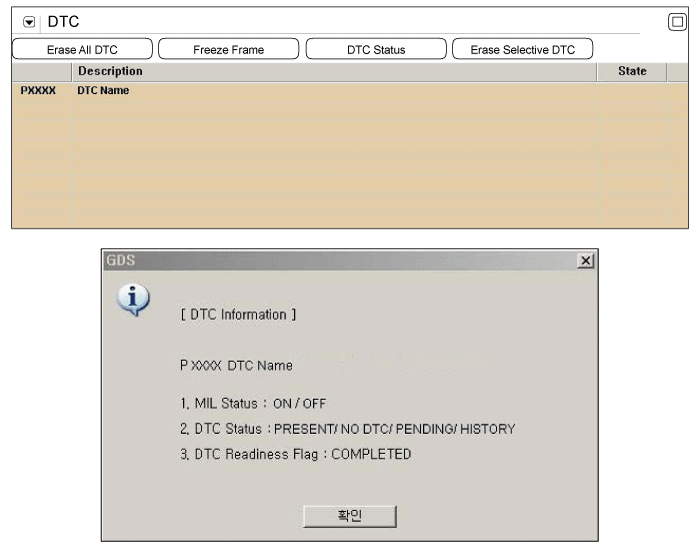
In order to control
emissions of the CO, HC and NOx components of the exhaust gas, heated
oxygen sensor (HO2S), mounted on the front side and rear side of catalytic
converter, detects the oxygen content in the exhaust gas. The front HO2S
signal is used to control air/fuel ratio (closed loop fuel control) and
the rear HO2S signal is used to monitor front HO2S and catalyst for proper
operation. The HO2S requires a minimum temperature to operate properly and
provide a closed loop fuel control system. The HO2S contains the heater
element to reduce its warming-up time and ensure its performance during
all driving conditions. The oxygen sensor generates a voltage that
indicates the difference between the oxygen content of the exhaust stream
and the oxygen content of ambient air. When the exhaust stream is “rich,”
there is more oxygen in the ambient air than in the exhaust stream, so the
voltage will be higher.
Checking output signals
from HO2S under detecting condition, if HO2S is not ready, PCM sets
P2A00.
Item
|
Detecting
Condition
|
Possible cause
|
DTC
Strategy
|
|
|
EnableConditions
|
| •
|
Engine Running at idle > 20
sec. | |
Threshold
value
|
|
Diagnosis
Time
|
| •
|
Continuous
(More than 10 second failure for every
12 second test .) | |
MIL On
Condition
|
|
(Reference only)
Test Condition
|
HO2S
Voltage(Sensor1)
|
HO2S
Voltage(Sensor2)
|
HO2S
Signal at idle after warm-up
|
Signal is
commonly switching from rich to lean more than 3 times in 10
sec.
|
Signal is
commonly above 0.6V.
|
HO2S
signal at open circuit(Pumping current OFF)
|
Approx. 0.45V
|
HO2S
signal at open circuit(Pumping current ON)
|
Approx. 3.5V
|

After warming-up, if
accelerator pedal is released suddenly around 4000rpm, the HO2S signal
reading will be lower than 200mV resulting from Fuel cut-off for the
moment. Conversely, if suddenly accelerator pedal is depressed, HO2S
signal reading will be around 0.6V ~1.0V. At idle, HO2S signal will switch
from lean to rich normally.
| 1. |
Check DTC Status
| (1) |
Connect scantool to Data Link
Connector(DLC). |
| (3) |
Select "DTC" button, and then Press "DTC
Status" to check DTC's information from the DTCs
menu. |
| (4) |
Read "DTC Status"
parameter.

|
| (5) |
Is parameter displayed "Present
fault"?
|

|
▶ Go
to "Component Inspection" procedure.
|
|

|
▶
Fault is intermittent caused by poor contact in the
sensor's and/or PCM's connector or was repaired and PCM
memory was not cleared. Thoroughly check connectors for
looseness, poor connection, ending, corrosion,
contamination, deterioration, or damage. Repair or
replace as necessary and go to "Verification of Vehicle
Repair"
procedure.
|
| |
| 1. |
Check the Signal waveform of HO2S
| (1) |
IG "OFF" and connect HO2S
connector. |
| (3) |
After warming-up, monitor signal
waveform of HO2S with scantool.

|
| (4) |
Is the sensor switching
properly?
|

|
▶
Check HO2S for poor connection/ installation or damage.
If O.K., Substitute with a known - good PCM and check
for proper operation. If the problem is corrected,
replace PCM and go to "Verification of Vehicle Repair"
procedure.
|
|

|
▶
Substitute with a known - good HO2S and check for proper
operation. If the problem is corrected, go to
"Verification of Vehicle Repair"
procedure.
|
|
There is a memory reset function
on scantool that can erase optional parts
automaticallydetected and memorized by PCM. Before or
after testing PCM on the vehicle, use this function to
reuse the PCM on the
others | | |
| Verification Of Vehicle
Repair |
After a repair, it is
essential to verify that the fault has been corrected.
| 1. |
Connect scantool and select "DTC"
button. |
| 2. |
Press "DTC Status" button and confirm that
"DTC Readiness Flag" indicates "Completed". If not, drive the
vehicle within conditions noted in the freeze frame data or enable
conditions |
| 3. |
Read "DTC Status"
parameter |
| 4. |
Is parameter displayed "History(Not Present)
fault"?
|

|
▶ System
performing to specification at this time. Clear the
DTC
|
|

|
▶ Go to the
applicable troubleshooting
procedure.
|
|